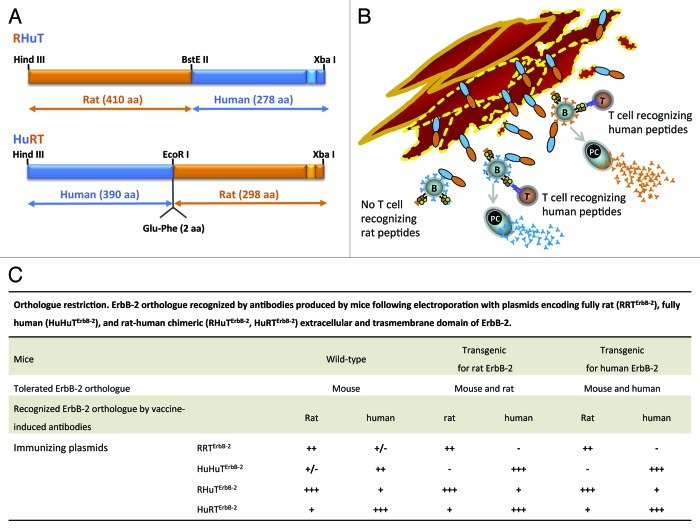Figure 2. Immunogenicity of chimeric proteins coded by rat-human (RHuTErbB-2) and human-rat (HuRTErbB-2) plasmids. RHuTErbB-2 encodes for a protein in which the 410 NH2-terminal residues are from the rat ErbB-2 extracellular domain and the remaining residues from human ErbB-2. HuRTErbB-2 encodes for a protein in which the 390 NH2-terminal residues are from human ErbB-2 and the remainder from rat ErbB-2 (A). The ability of B cells (B) to present not-tolerated peptides contributes to production of an antibody response to both the tolerated and not-tolerated moieties of the antigen. Following a DNA electroporation of a rat ErbB-2 tolerant mouse muscle with a plasmid encoding for a rat (orange) and human (blue) chimeric ErbB-2 protein (RHuTErbB-2 or HuRTErbB-2), T cells (T) recognizing the xenogeneic human peptides expands. The expanded T cells interact and provide helper signals to B cells by recognizing not-tolerated human peptides (blue triangles) presented by MHC II molecules on the cell membrane of B cells. The interaction between T and B cells recognizing human moiety of the encoded vaccine leads to the production by plasmacells (PC) of antibodies (blue Y) to the xenogeneic human moiety. By contrast, the interaction of expanded T cells with B cells specific for a tolerated rat moiety help to break immune tolerance to self protein leading to the production by plasmacells (PC) of antibodies (orange Y) to the tolerated rat moiety (B). ErbB-2 ortholog recognized by antibodies produced by mice following electroporation with plasmids encoding fully rat (RRTErbB-2), fully human (HuHuTErbB-2), and rat-human chimeric (RHuTErbB-2, HuRTErbB-2) extracellular and trasmembrane domain of ErbB-2 (C).

An official website of the United States government
Here's how you know
Official websites use .gov
A
.gov website belongs to an official
government organization in the United States.
Secure .gov websites use HTTPS
A lock (
) or https:// means you've safely
connected to the .gov website. Share sensitive
information only on official, secure websites.
